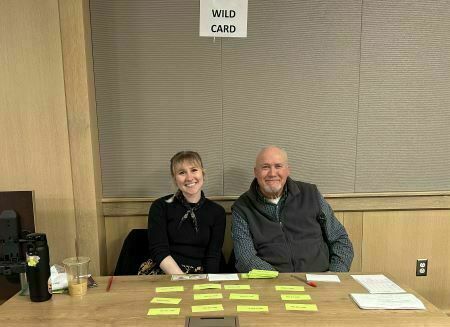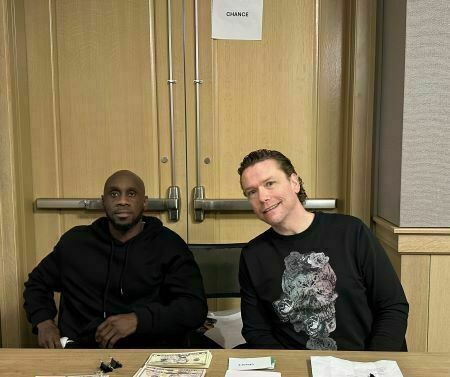What is life like after prison or jail? How do individuals who have experienced incarceration reacclimate to society once they are outside of prison? Moreover, what systems and structures are in place to support them -- or to hold them back?

On Friday, March 22, staff members from the Ansari Institute and the Center for Social Concerns joined in an interactive session with faith leaders, community members, and returning citizens for an opportunity to learn how challenging it can be for individuals returning from incarceration. At the Center for Social Concerns, faculty, staff, and students discuss how individuals and society can use moral imagination to solve complex problems. Yet, it is difficult to fully realize or understand both the pure volume and the complexity of unintended consequences that have been built into the system of post-incarceration. That's where an opportunity like a simulation is helpful.
Instead of a presentation or a video, this event – part of the Living Matthew 25 series – was organized to present a reasonable facsimile of what an person might experience during their re-entry. Participants were invited to navigate through the first four weeks of the journey while also attempting to comply with all the requirements of supervised release.

The Living Matthew 25 series is led by South Bend’s 1st Presbyterian Church. It references the well-known Biblical passage Matthew 25:35 that says “For I was hungry and you gave me something to eat, I was thirsty and you gave me something to drink, I was a stranger and you invited me in, I needed clothes and you clothed me, I was sick and you looked after me, I was in prison and you came to visit me.” Living Matthew 25 includes movies, book discussions, speakers, and other service opportunities throughout the Christian period of Lent.
Participants in the simulation were able to experience first hand what it might be like to wait hours in line to see a caseworker only to discover they did not have the necessary documents required for the assistance; to check in each week with parole officers and to pay with their limited resources to have their urine tested each week, and then to pay each month for their required supervision; to be told to be applying for jobs, attending counseling, attending treatment, attending AA meetings, and attending interviews all while under-resourced and - often - without money for food or bus passes or basic necessities.
For Rebekah Go, Program and Communications manager at the Ansari Institute, the simulation was emblematic of the Ansari Institute’s focus on narrative empathy. One conversation that stood out wasn’t even part of the simulation but the real life experience of one of the volunteers. Alicia Wells shared that she had been out of prison for 12 years, yet because of her felony convictions she was being prohibited from attending her fifth grade son’s field trip. She said, “I’m trying to be the mother they tell me they want me to be. And then they won’t let me. I’m supposed to have paid my debt to society but it never ends.”
Felonies can fall off individuals’ records in the state of Indiana after five years, depending on the crime. However, the process is so complex that even a judge himself could not initially figure it out and has developed a solution that only works in one specific county in the state of Indiana. This is something that Justin McDevitt, Director of the Women's College Partnership (WCP) at Indiana Women's Prison (in partnership with Marian University) in the Notre Dame Programs for Education in Prison (NDPEP) knows well from his dissertation work. He has mapped out thousands of consequences in employment, education, housing, and government assistance that each have internal and external repercussions for those who are trying to return to life after incarceration.

McDevitt and his colleagues Jim Cunningham and Paige Osika, Assistant Program Directors, NDPEP, were in attendance not only to volunteer at the re-entry simulation but to consider ways that it might be reproduced with community partners for returning citizens in the Indianapolis area as well. “Being in prison is hard, but getting out of prison is hard too. We can make a real impact in removing barriers for people returning to our communities just by being aware of the challenges they face, then finding ways to open doors for others.”
Indeed the re-entry simulation has already begun to make the rounds: the Dismas House of Indiana brought it to the National Black Catholic Congress in July. Dismas House originally developed the re-entry simulation based on a similar program developed by local community partner Goodwill of Northern Indiana. That simulation looked broadly at poverty and continues to be a popular exercise at local leadership trainings. However, because the Dismas House focus is exclusively on returning citizens and the challenges of returning citizens are more complex, the program was refined. Last spring, a group of Notre Dame students in the Student Policy Network worked with Life Outside Reentry Assistance to bring a version to campus that was attended by dozens of students.
This year’s simulation was sponsored by First Presbyterian Church, Dismas House of Indiana, the St. Joseph County Public Library, The Beacon, Life Outside, and Goodwill Industries of Michiana, Inc..